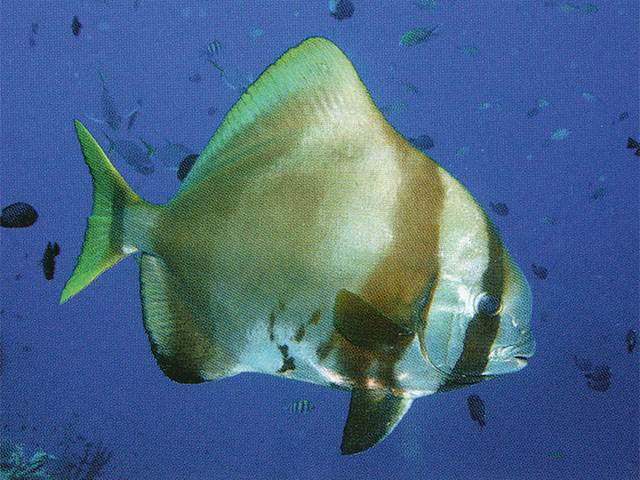| Ephippidae (Spadefishes, batfishes and scats) |
| 65 cm SL (male/unsexed) |
|
reef-associated; marine; depth range 5 - 40 m |
| Indo-West Pacific: Madagascar to Indonesia and Australia (Ref. 2334, 3131). |
|
Dorsal spines (total): 6-7; Dorsal soft rays (total): 28-31; Anal spines: 3-3; Anal soft rays: 19-23. Adults (above 40 cm) silvery, with dark bar through eye and another (faint) bar just behind head. Fins dusky. Small juveniles black, vertical white lines on body and fins. Subadults brown, with black bar from nape, over eye to chest and another black bar from dorsal-fin origin, over pectoral fins to pelvic fins, pectoral and pelvic fins dark brown or black. Body orbicular and strongly compressed, its depth more than twice length of head and 1.1 to 1.9 times in SL. Snout profile of large adults (above 40 cm) concave, with prominent bony swelling between eyes. Jaws with bands of slender, flattened, tricuspid teeth, the middle cusp 3 to 4 times longer than lateral cusps. Vomer with a band of strong teeth, no teeth on palatines. Five pores on each side of lower jaw. Preopercle smooth. Opercle without spines (Ref 43039). |
| Inhabits continental reefs (Ref. 9710). Adults usually moderately deep on open substrates with sparse reef or coral heads. A solitary species, but occasionally in pairs or small groups. Small juveniles also in deep water and the zebra-pattern serves well as camouflage when sheltering with crinoids (Ref. 48637). Juveniles in shore waters; adults in deeper water. |
|
Not Evaluated (N.E.) Ref. (130435)
|
| harmless |
Source and more info: www.fishbase.org. For personal, classroom, and other internal use only. Not for publication.

